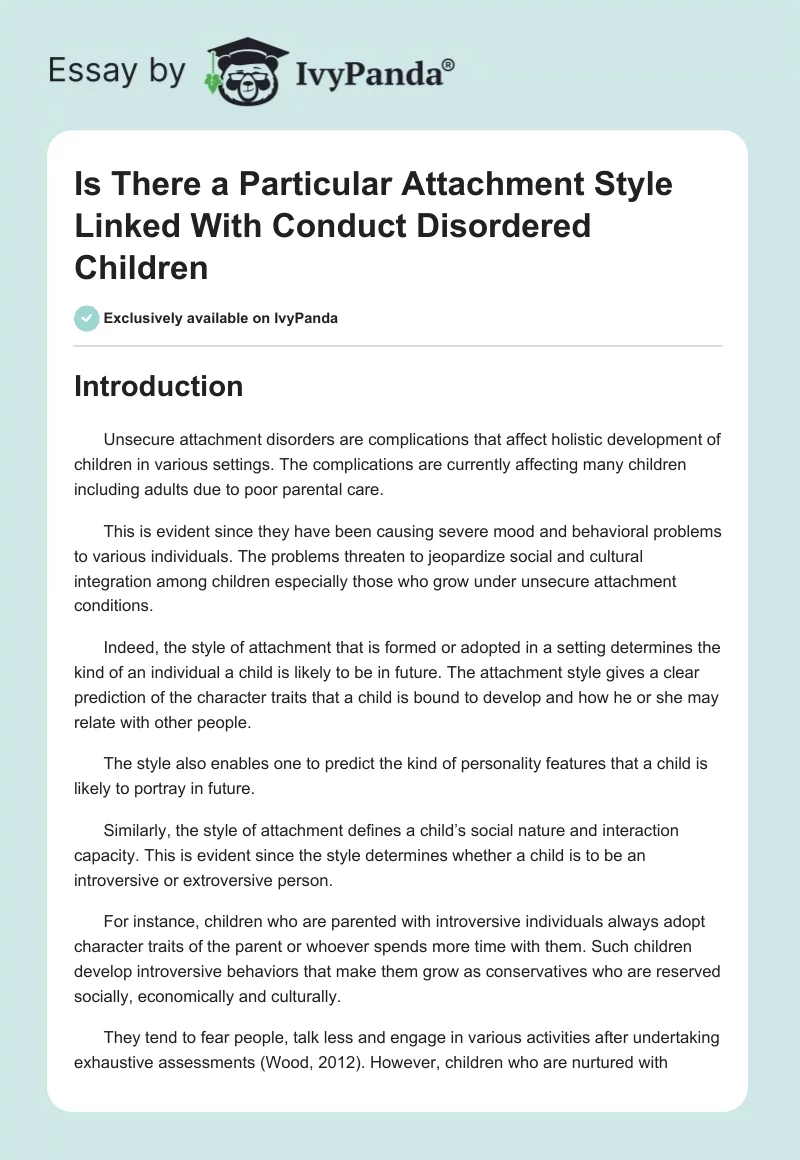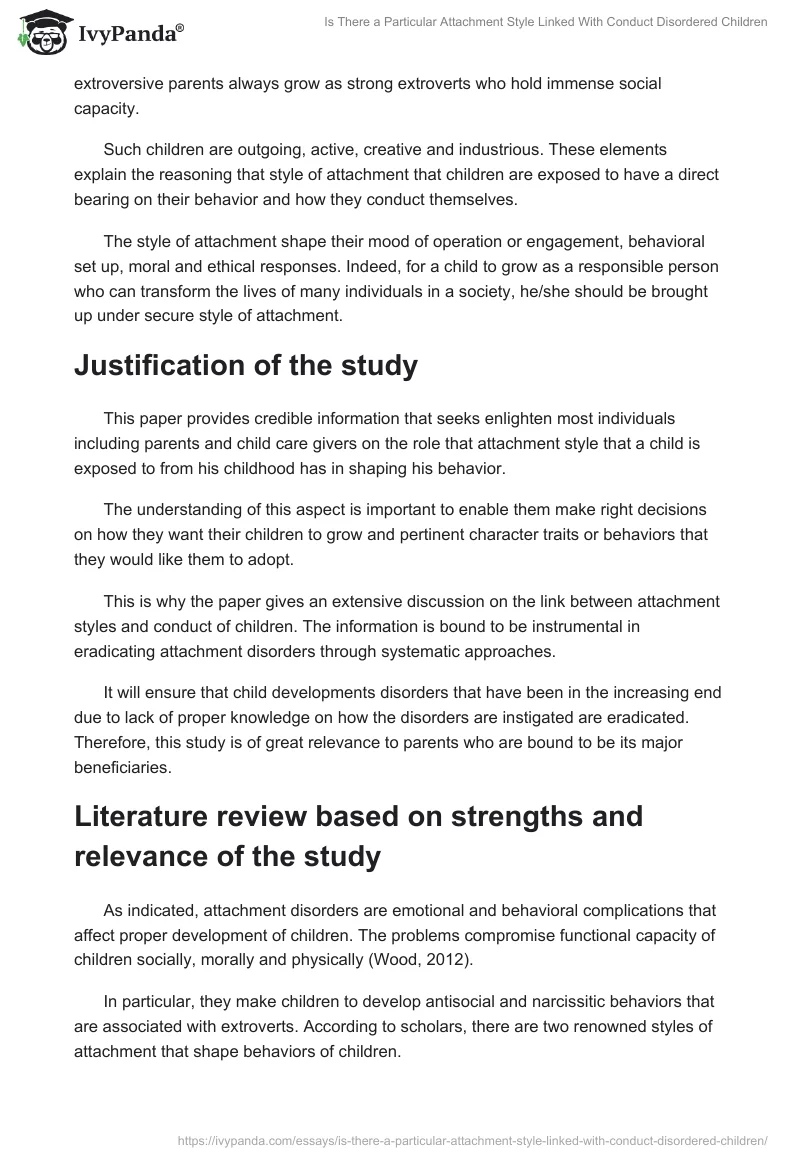Introduction
Unsecure attachment disorders are complications that affect holistic development of children in various settings. The complications are currently affecting many children including adults due to poor parental care.
This is evident since they have been causing severe mood and behavioral problems to various individuals. The problems threaten to jeopardize social and cultural integration among children especially those who grow under unsecure attachment conditions.
Indeed, the style of attachment that is formed or adopted in a setting determines the kind of an individual a child is likely to be in future. The attachment style gives a clear prediction of the character traits that a child is bound to develop and how he or she may relate with other people.
The style also enables one to predict the kind of personality features that a child is likely to portray in future.
Similarly, the style of attachment defines a child’s social nature and interaction capacity. This is evident since the style determines whether a child is to be an introversive or extroversive person.
For instance, children who are parented with introversive individuals always adopt character traits of the parent or whoever spends more time with them. Such children develop introversive behaviors that make them grow as conservatives who are reserved socially, economically and culturally.
They tend to fear people, talk less and engage in various activities after undertaking exhaustive assessments (Wood, 2012). However, children who are nurtured with extroversive parents always grow as strong extroverts who hold immense social capacity.
Such children are outgoing, active, creative and industrious. These elements explain the reasoning that style of attachment that children are exposed to have a direct bearing on their behavior and how they conduct themselves.
The style of attachment shape their mood of operation or engagement, behavioral set up, moral and ethical responses. Indeed, for a child to grow as a responsible person who can transform the lives of many individuals in a society, he/she should be brought up under secure style of attachment.
Justification of the study
This paper provides credible information that seeks enlighten most individuals including parents and child care givers on the role that attachment style that a child is exposed to from his childhood has in shaping his behavior.
The understanding of this aspect is important to enable them make right decisions on how they want their children to grow and pertinent character traits or behaviors that they would like them to adopt.
This is why the paper gives an extensive discussion on the link between attachment styles and conduct of children. The information is bound to be instrumental in eradicating attachment disorders through systematic approaches.
It will ensure that child developments disorders that have been in the increasing end due to lack of proper knowledge on how the disorders are instigated are eradicated. Therefore, this study is of great relevance to parents who are bound to be its major beneficiaries.
Literature review based on strengths and relevance of the study
As indicated, attachment disorders are emotional and behavioral complications that affect proper development of children. The problems compromise functional capacity of children socially, morally and physically (Wood, 2012).
In particular, they make children to develop antisocial and narcissitic behaviors that are associated with extroverts. According to scholars, there are two renowned styles of attachment that shape behaviors of children.
The two key styles that present positive and negative influences in human life as they develop from childhood include secure and unsecure attachment styles. The two types of attachment styles present various consequences in human life especially from childhood to adulthood.
This is because they contribute in inculcating specific behaviors in individuals that become difficult to change. The behaviors that the two styles help in nurturing define individual’s lifestyle, perception and how one is likely to relate with others (Ribner, 2002).
In particular, secure attachment is a child parenting style that is based on ideal principles and guidelines. The style provides basic incentives that ensure that a child is nurtured in the right way. Notably, it ensures that positive behaviors are inculcated in a child.
That is the person who is providing the parental care is bound to teach the child noble things that are socially accepted. He is also responsible to expose the child to only good things that can enable him grow as a responsible individual who conduct himself with dignity.
As noted by Ribner (2002), securely attached children normally have limited complications in life. They are hardworking, very social, they excel in class and they make friendship very easily.
Conversely, unsecure attachment forms the second style of attachment that affects holistic development of children. The style is known for its evident limitations that present far reaching effects in the development of a child.
Similarly, it is depicted as the worst style of parenting in most settings since it is linked to conduct disorders that compromises moral values and good behaviors that children are expected to uphold.
Its disorders present severe emotional, behavior and moral complications that inculcate inferiority related complexities in children. This disorder is caused when parenting process is not executed properly (Zelazo, 2013).
Firstly, it is caused when there is a total negligence when it comes to child protection and guidance. A child requires proper guidance in order to enable him develop good behavior by parents or care givers.
They must not be allowed to watch bad videos, they should be taught decent ways of eating and relating with older people. Based on the facts presented, it is prudent to note that unsecure attachment style of parenting has a direct link with conduct disorders in children.
This is apparent since it exposes children to complications that include antisocial, narsissitic and schizotypal that affects their wellbeing. The disorders remain key aspects that define individual’s weaknesses and personal failure (Delfos, 2004).
Areas of contention and weaknesses
Imperatively, there has been a great contention on whether conduct disorders in children are complications that are caused due to inferior styles of child parenting or whether they are instigated by other factors (Shohov, 2003).
The issues has brought sharp divisions among individuals in various nations with one school of thought asserting that it is what a child is exposed to daily and perform frequently, that shape his behavior.
They note that children tend to borrow the behaviors and character traits of their parents or care givers who spend more time with them.
However, critics of the notion indicate that conduct disorders in children cannot be said to be exclusively caused by the style of attachment that one is exposed to from childhood.
They hold that behaviors are based on character traits of individuals that can be developed over time depending on the environment that one operates (Levine & Munsch, 2011).
Similarly, they assert that there are various factors that influence the behavior of children and that may result to conduct disorders. Most critics of the notion hold that conduct disorder is a universal problem that affects children regardless of the parenting style that they are exposed to.
They believe that attachment disorders or good behaviors are genetically transferred character traits that cannot be transformed easily. Their explanation is that children in most instances are born with certain behaviors or character traits that are natural (Mikulincer & Shaver, 2010).
The behaviors may not be seen in their early childhood, but can be evident in later stages of life as he develops.
They also hold that conduct disorders are shaped depending on the age of an individual. In most cases, individuals tend to change the way they execute various activities and behavior as they grow.
Results and Findings
Clearly, behavior development in children starts from early stages in life. The behaviors that they portray are dependent on how they are brought up, taught and how they are parented.
Other behaviors that children develop are also dependent on genetic ideals or character traits that are genetically transferred (Flores, 2004). It is imperative to note that how a child is brought up is how he is bound to be in future.
If a child is parented well and taught good moral values, that child will be an exemplary person who respect people. However, if a child is parented poorly the end results are severe attachment disorders that compromise their capacity socially, morally and intellectually.
Children, who are parented well under secure attachment parenting style, are always social people who interact with everyone regardless of age without fear.
They are industrious, confident, excel in school, make friends easily and are self-reliant. These virtues are inculcated in them as they grow by those who parent them. Consequently, children who develop bad behaviors are deemed to have not received proper parenting at their infant stages.
Such children suffer from attachment disorder complications that impede their productivity. They are antisocial, fearful, and reserved in various aspects. Indeed, attachment style that a child is exposed to defines his behavior currently and in future.
This beats the logic that is being introduced by the critics of this notion that parenting style has nothing to do with behavior. Therefore, parents have to know that behavior is nurtured and it is emulated in most cases (Flores, 2004).
For instance, when one associates with a criminal then the person is likely to develop criminal behaviors.
When one associates with a Christian, he is bound to display noble behaviors and character of Christians. This happens since people tend to adopt behaviors that are presented to them by the environment.
Conclusion
Indeed, for a child to grow as a responsible person who can transform the lives of many individuals in a society, he or she should be brought up under secure style of attachment.
This is essential to ensure that he does not develop severe attachment disorders that affect individual’s social, moral, emotional and mental stability.
Parents must therefore ensure that they inculcate noble life ideals in their children from childhood by exposing them to secure style of attachment in the society.
They must teach their children good values when they are still infants since the lessons they get when they are young whether visual or audio, affects their future engagements with others.
References
Delfos, F. (2004). Children and Behavioural Problems: Anxiety, aggression, depression and ADHD, a Biopsychological Model with Guidelines for Diagnostics and Treatment. London [u.a.: Jessica Kingsley.
Flores, J. (2004). Addiction as an Attachment Disorder. Lanham (Md.: J. Aronson.
Levine, E. & Munsch, J. (2011). Child Development: An Active Learning Approach. Thousand Oaks, Calif: SAGE.
Mikulincer, M. & Shaver, P. (2010). Attachment in Adulthood: Structure, Dynamics, and Change. New York: Guilford Publications.
Ribner, G. (2002). California School of Professional Psychology Handbook of Juvenile Forensic Psychology. San Francisco, CA: Jossey-Bass.
Shohov, P. (2003). Advances in Psychology Research: Volume 21. New York: Nova Science Publishers.
Wood, M. (2012). Reactive Attachment Disorder: A Disorder of Attachment or of Temperament. Web.
Zelazo, D. (2013). The Oxford Handbook of Developmental Psychology. New York, NY: Oxford University Press.



